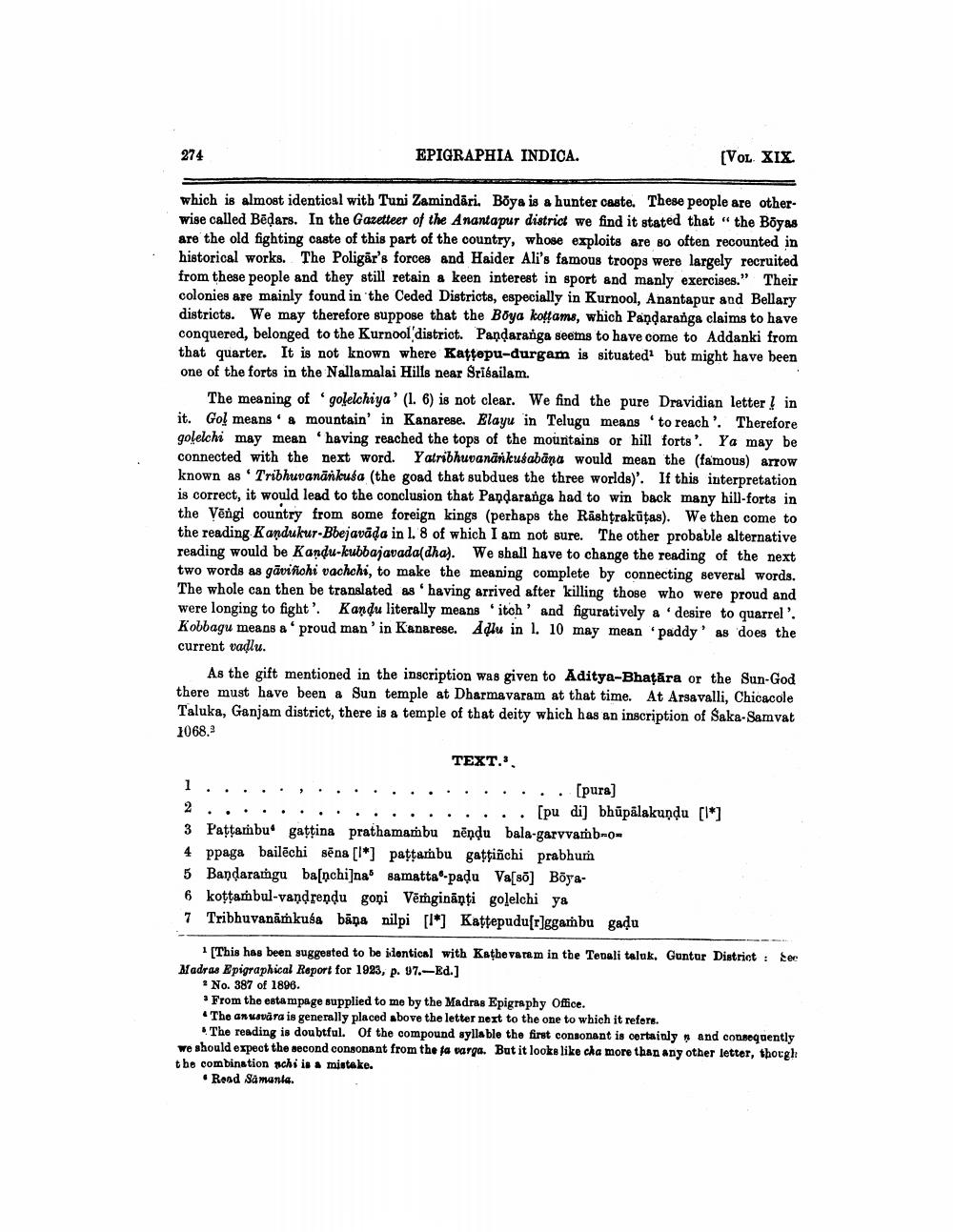________________
274
EPIGRAPHIA INDICA.
[VOL. XIX.
which is almost identical with Tuni Zamindari. Boya is a hunter caste. These people are otherwise called Bēḍars. In the Gazetteer of the Anantapur district we find it stated that "the Bōyas are the old fighting caste of this part of the country, whose exploits are so often recounted in historical works. The Poligär's forces and Haider Ali's famous troops were largely recruited from these people and they still retain a keen interest in sport and manly exercises." Their colonies are mainly found in the Ceded Districts, especially in Kurnool, Anantapur and Bellary districts. We may therefore suppose that the Boya kottams, which Pandaranga claims to have conquered, belonged to the Kurnool district. Pandaranga seems to have come to Addanki from that quarter. It is not known where Kattepu-durgam is situated1 but might have been one of the forts in the Nallamalai Hills near Srisailam.
The meaning of golelchiya' (1. 6) is not clear. We find the pure Dravidian letter in it. Gol means a mountain' in Kanarese. Elayu in Telugu means to reach'. Therefore golelchi may mean having reached the tops of the mountains or hill forts'. Ya may be connected with the next word. Yatribhuvanankusabana would mean the (famous) arrow known as Tribhuvanänkuśa (the goad that subdues the three worlds)'. If this interpretation is correct, it would lead to the conclusion that Pandaranga had to win back many hill-forts in the Vengi country from some foreign kings (perhaps the Rashtrakutas). We then come to the reading Kandukur-Bbejavāda in 1. 8 of which I am not sure. The other probable alternative reading would be Kandu-kubbajavada(dha). We shall have to change the reading of the next two words as gaviñohi vachchi, to make the meaning complete by connecting several words. The whole can then be translated as 'having arrived after killing those who were proud and were longing to fight'. Kandu literally means itch' and figuratively a desire to quarrel'. Kobbagu means a proud man' in Kanarese. Adlu in 1. 10 may mean 'paddy' as does the current vaḍlu.
As the gift mentioned in the inscription was given to Aditya-Bhațăra or the Sun-God there must have been a Sun temple at Dharmavaram at that time. At Arsavalli, Chicacole Taluka, Ganjam district, there is a temple of that deity which has an inscription of Saka-Samvat 1068.2
TEXT.'
[pura]
[pu di bhüpalakundu [*]
2
3 Paṭṭambu gaṭṭina prathamambu neņḍu bala-garvvamb-o
4 ppaga bailechi sena [*] paṭṭambu gaṭṭiñchi prabhum
5 Bandaraṁgu ba[nchi]na samatta"-padu Va[so] Boya
6 koṭṭambul-vandrendu goni Vemginanți golelchi ya
7 Tribhuvanaṁkusa bana nilpi [1] Kattepudu[r]ggambu gadu
1 [This has been suggested to be identical with Kathe varam in the Tenali taluk. Guntur District: See Madras Epigraphical Report for 1923, p. 97.-Ed.]
2 No. 387 of 1896.
From the estampage supplied to me by the Madras Epigraphy Office.
The anusvara is generally placed above the letter next to the one to which it refers.
The reading is doubtful. Of the compound syllable the first consonant is certainly and consequently we should expect the second consonant from the fa varga. But it looks like cha more than any other letter, though the combination achi is a mistake.
• Read Samanta.




